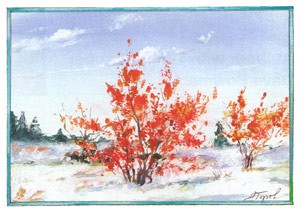
Extensive wetlands often have masses of winterberry. From afar, its abundant, bright red berries sometimes cause large areas of wetland shrubbery to glow with a reddish orange color well into the winter. This shrub is willing to grow with its roots deeply submerged at the edges of ponds, and in these situations, the fruits’ watery reflections double the apparent redness. There isn’t a lot of red in the rest of the winter landscape, and winterberry berries are cheerfully bright. A snowy background intensifies the effect.
This winter beauty has long been recognized by plant breeders who have created dozens of cultivars, many with the berry color in the variety name: you can buy a Jolly Red, Red Sprite, Ruby Red, Scarlet O’Hara, Stoplight, or a Winter Red winterberry at a nursery near you. The native species varies in height, berry color, and shape, and the cultivars have greatly expanded this range of traits.
From March to October, this shrub is also very pretty, though not so noticeable. It is multi-stemmed, with dense, fine, twiggy branches, and in the North it grows to about 10 feet high. The glossy, dark green, oval leaves range from 1 1/2 to 3 inches long, have small, sharp serrations, and usually are hairy on the undersides, especially on the veins.
The veins are distinctive: instead of reaching from the midrib toward the margin, as they do in most plants, the veins form a network, a pattern known to botanists as reticulate venation. This will help you identify winterberry when it is not winter and when there are no berries. This is important, as there will be no berries on about half of the winterberry plants year-round, because male plants do not produce berries. The pollen they produce, however, is essential to berry production, so if you buy a Winter Red, for instance, you will need to buy a male plant as well. Landscapers tend to tuck the male plants behind the favored females.
The cream-colored male and female flowers bloom in June or July and are short-stalked, hugging the stem as the berries do later on. They are small enough to go unnoticed by us humans but are extremely attractive to insects, especially bees, as both male and female flowers produce copious amounts of nectar. Although the quality of honey from winterberry isn’t known, its genus, Ilex, has a reputation for producing very good-tasting honeys.
Winterberry, also called black alder or northern holly, is the most northern of the hollies, and, unlike some of its more famous southern cousins, it sheds its leaves in autumn. At home from zones 3 to 9, it ranges from Newfoundland to Michigan and south to Indiana, West Virginia, and Maryland. Although in the wild it is often found in wet soil and prefers soils that are high in organic matter and somewhat acidic, it is a tough plant that also grows well in average soil. It even tolerates a fair measure of drought once established. Pests and diseases are few, though it is susceptible to an occasional bout of powdery mildew and a couple of minor leaf fungi. In alkaline soils, the foliage may be an unhealthy yellowish green.
In nature, winterberry spreads by seeds, suckers, and layering. Layering is a way of producing new plants, both in nature and in the greenhouse, when branches fall or are pressed into the soil, allowing roots to form while the branch is still attached to the parent plant. Unless they are specially treated, most seeds will not germinate until the second spring after they are sown. Plants can more easily be grown from cuttings.
Winterberry fruits are preferred fall and winter food for mockingbirds, catbirds, brown thrashers, and hermit thrushes and are also eaten by black ducks, flickers, crows, robins, veeries, and cedar waxwings. Red-winged blackbirds not only eat the fruits but also use this shrub for cover and nesting.
The berries of some cultivars described in one landscaping book are less attractive to birds than the native berries. This is considered a point in favor of some of the non-natives, but I’m glad they mention it: these cultivars are the ones that I will know to avoid.
For those of us whose houses don’t overlook winterberry wetlands, cut branches can be brought indoors anytime after October to brighten the house. The birds probably can spare you a few berries.


Discussion *